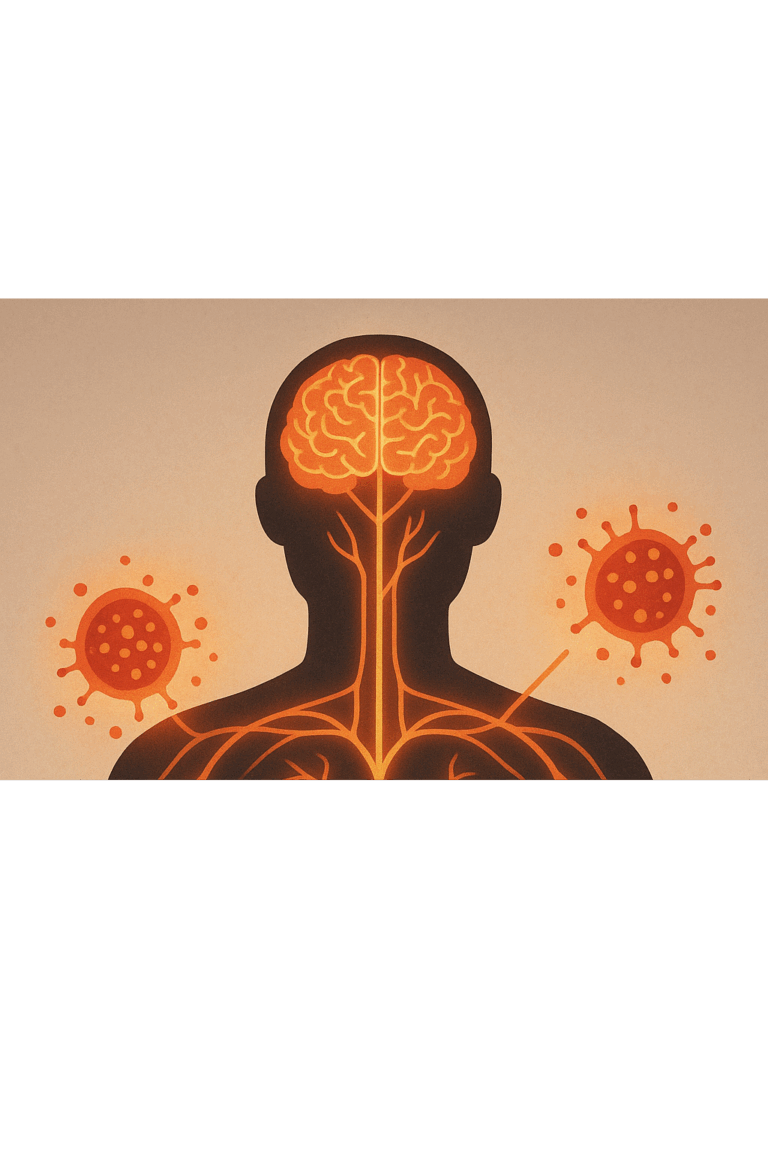- What Causes chronic pain in Fibromyalgia and Hypermobility - 27 June 2025
- Mast Cells and Fibromyalgia: The Hidden Connection - 19 June 2025
This article covers:
ToggleThe Nervous System’s Role in Pain
If you’ve ever flinched at the sound of someone chewing, struggled with bright lights in a shop, or felt like certain fabrics make your skin crawl, it’s completely understandable. For those dealing with fibromyalgia or hypermobility, these kinds of sensory experiences can become overwhelming, even painful. And what’s more frustrating is that they rarely make sense to anyone else.
The truth is, your body is not broken. But your nervous system might be a little overworked. Sensory processing is one of those things that we usually don’t even think about, until it starts going wrong. When the brain starts misinterpreting harmless sensations as potential threats, everyday life can start to feel like walking through a minefield. Some Individuals also experience heightened reactions due to other factors, things like Mast Cell Activation Syndrome, which can further amplify the sensory sensitivity.
Whether it’s the discomfort of clothes rubbing against your skin, feeling clumsy and unsure of your footing, or flaring pain from something as simple as a light touch, these aren’t just quirks or annoyances. They’re signals that your sensory system is having a hard time filtering and processing the world around you.
And when that system is overwhelmed, the results aren’t just uncomfortable. They can be completely debilitating.In this article, I want to help you understand what’s actually happening beneath the surface. Because when we understand how the nervous system processes pain and sensation, we can start to find better ways of working with it, instead of constantly fighting against it.
Sensory Hypersensitivity in Fibromyalgia
One of the most misunderstood parts of fibromyalgia is just how sensitive the world can suddenly become. I’m not talking about being a bit bothered by noise or not liking strong smells. I mean full-blown overwhelm. The kind where certain lights make you feel sick, where the texture of a jumper can make your skin feel like it’s on fire, or where someone’s perfume lingers in your head for hours and triggers a flare. These triggers can often cause pretty severe headaches in those with Fibromyalgia.
It’s not just in your head. The research is clear. People with fibromyalgia experience far greater levels of sensory hypersensitivity compared to the general population. And it’s not just one sense that gets affected. We’re talking about touch, smell, hearing, vision, taste, and even balance (1, 2, 6).
What’s particularly interesting is that some of these sensory changes go in both directions. While there’s often intense hypersensitivity, there can also be areas of hyposensitivity. That means parts of the body can feel numb or dull, or you might struggle with things like fine motor skills or bumping into doorframes. It’s not clumsiness. It’s your brain struggling to accurately map where your body is in space (1, 2).
Studies using validated tools like the Sensory Perception Quotient and the Glasgow Sensory Questionnaire have shown that people with fibromyalgia score significantly higher for hypersensitivity across every sensory domain. Touch, vision, and smell tend to be the most problematic, but the effects can be widespread (6, 2).
One study summed it up pretty well when it said, “Fibromyalgia is linked to both increased multisensory hypersensitivity and hyposensitivity, but with a far larger group difference for hypersensitivity” (6).
And if you’re reading this and nodding along, thinking about how often you feel overloaded or overstimulated, then this is something that deserves to be recognised in your care. These sensory issues aren’t just “weird symptoms” to be brushed off. They’re part of the central mechanisms that drive fibromyalgia, and they affect everything from your pain levels to your energy, mood, and movement.
Understanding that the brain is receiving and interpreting all this input through an already sensitive filter can help make sense of why everything feels louder, brighter, rougher, and more intense. And why that same filter makes it so hard to switch off or feel safe in your own body.
It’s not weakness. It’s a system working overtime.
Proprioception and Hypermobility
If you’ve ever felt unsure of where your foot is on a step, or like your limbs don’t quite belong to you, then you’ve already experienced what poor proprioception feels like. And if you’re hypermobile, this is probably something that’s followed you around for years.
Proprioception is your brain’s ability to know where your body is in space without needing to look. It’s what allows you to move your arms, shift your weight, or walk through a narrow doorway without banging into the frame. When that sense is dulled, even the simplest movements can become unpredictable. And if your joints are already more mobile than they should be, that missing feedback makes everything a bit harder to control.
Research shows that people with hypermobile joints often have reduced proprioceptive feedback, especially in weight-bearing joints like the knees, hips, and ankles (8). This means that when you’re walking or trying to balance, your brain is working with patchy or delayed information. It’s a bit like trying to drive with foggy windows and a dodgy sat nav.
One study put it plainly. “People who have hypermobile joints tend to have decreased proprioception. The sense of where you are in space, where your joints are, and at what angles they are being held is decreased, especially in weight-bearing joints… This can lead to general clumsiness, but it can also lead to pain when joints are pushed beyond their limits without the awareness needed to initiate a protective response” (8).
And this is exactly what we see in practice. It’s not just about tripping or bumping into things. It’s about joints being placed into vulnerable positions without the brain getting enough warning to do anything about it. Over time, this creates a cycle of micro-injuries, instability, and increased pain. Especially in the joints that are already more fragile due to collagen differences.
That said, it’s not all doom and gloom. The nervous system is plastic. That means it can change and adapt. With the right kind of feedback, including visual, tactile, and movement based input, we can start to rebuild those maps in the brain and improve the accuracy of joint control. This doesn’t mean fixing the joint itself. It means helping the brain understand what it’s feeling, so it can make better decisions about movement, that’s where a lot of the magic starts to happen.
Central Sensitisation and Pain Processing
When we talk about pain in fibromyalgia, we’re not just talking about sore muscles or aching joints. We’re talking about a brain that’s started to process pain very differently. One that has, over time, become more sensitive to the signals coming in. A nervous system that now sees harmless sensations as something to be feared or avoided. This is what central sensitisation is all about.
Central sensitisation is a process where the nervous system becomes overly responsive. It doesn’t just react to pain. It starts to anticipate it. Amplify it. Hold onto it for longer than it should. And it does this by making the brain and spinal cord more excitable. Which means that things that shouldn’t hurt now do. And things that used to hurt a little now hurt a lot.
Functional MRI studies have shown that people with fibromyalgia have significantly more brain activity in pain-processing areas than healthy individuals, even when the stimulus is mild (3, 4). The insula, the somatosensory cortex, the brainstem, and the spinal cord are all working overtime. It’s like someone turned the volume knob right up, but lost the ability to turn it back down.
One study describes this really well. “Fibromyalgia is a chronic pain disorder, where abnormal temporal summation of second pain has been demonstrated… We characterised the time course of spinal cord and brainstem activity during second pain, which showed abnormal brainstem activity in patients with fibromyalgia, possibly due to deficient pain modulation” (5).
This is where it gets interesting. Central sensitisation isn’t just about pain. It also affects how we process other kinds of sensory input. So if loud noises feel unbearable, if touch feels threatening, if your body struggles to tune out background signals like clothing or the pressure of sitting, it’s all part of the same pattern (7).
And here’s the thing. It’s not that your body is broken. It’s that your brain has become incredibly good at detecting danger. Too good. So good that it’s started to see normal sensations as something to guard against. And once that system is on high alert, it can be hard to shut it off.
That doesn’t mean it’s permanent. But it does mean we need to stop thinking about pain as something purely structural. This is neurological. It’s sensory. And it’s deeply real.
Helping the Nervous System Feel Safe Again
Understanding how sensory processing works is one thing. Living with it every day is something else entirely. When your nervous system is on high alert, and the brain is struggling to make sense of all the input flooding in, life can start to feel like you’re constantly walking through treacle. Heavier, slower, harder.
This is why the focus often has to shift away from trying to fix individual symptoms, and instead towards giving the nervous system the kind of input that helps it feel safe, stable, and in control. And one of the most effective ways to do that is through the breath.
More specifically, through something called CO₂ pooling.
This technique involves slow, controlled breathing that helps increase the level of carbon dioxide in the blood. Now that might sound counterintuitive at first. After all, we’re usually taught to focus on oxygen. But CO₂ is just as important, especially when it comes to calming a nervous system that’s stuck in fight-or-flight mode (10, 11, 12).
By gently raising CO₂ levels, you activate the parasympathetic nervous system. That’s the part of your nervous system responsible for rest, digestion, and repair. You’re effectively telling your body that it’s safe. That it can stand down. And that shift can be powerful (10, 11).
The benefits don’t stop there. This kind of breathing also stimulates the vagus nerve, which helps regulate heart rate, lowers stress hormones, and supports emotional calm (11, 12). For people living with fibromyalgia and hypermobility, where the stress response is often overactive, that’s a really big deal.
We see a lot of our clients with chronic pain who unknowingly hyperventilate throughout the day. Not the dramatic kind you see in films, but subtle overbreathing. A slightly open mouth. Shallow chest movement. Small things that, over time, lower CO₂ and increase nervous system irritability. The result is more sensory sensitivity, more fatigue, and more pain (10, 13).
Practising CO₂ pooling teaches the body to tolerate and work with this gas again. It helps reintroduce a sense of stillness and stability. It can improve pain tolerance, reduce anxiety, and even help rebuild the brain’s sense of where your body is in space (11, 13).
And it is something you can do at home. Quietly. Gently. Without any equipment. No pressure. Just learning to work with your breath in a way that soothes the system, instead of feeding the stress loop.
This isn’t about chasing relaxation. It’s about restoring the baseline your nervous system needs in order to feel safe, And when your system feels safe, everything else starts to feel just a little more manageable.
Alongside CO₂ pooling, there are other ways to help the nervous system build more accurate and calming feedback.
Simple things can go a long way. Using mirrors while moving can help reinforce what your joints are doing in space. It gives the brain a bit of visual backup. Tactile cues are also helpful. Things like hands-on feedback or wearing compression clothing can give your nervous system something more concrete to work with, however don’t wear them all the time as the nervous system may just get used to them and turn down its effect, also keep in mind that compression, while helpful for some, can feel overwhelming for others, especially if there’s a lot of tactile sensitivity. Gentle stretching can be another great way to offer your nervous system some calming, reassuring feedback.
Weighted items like blankets or lap pads also fall into this category. Some people find them grounding. Others find them too much. Spending more time outdoors has shown to be beneficial. Remember though, this isn’t about finding the perfect tool. It’s about figuring out what feels safe and supportive for you.
We also use sensory integration strategies. Gently working with one type of input at a time. This might mean slowly reintroducing certain textures, or building tolerance to sound or light in a safe and controlled way. The aim is not to desensitise you by force. It’s to help the system recalibrate, one piece at a time (1, 6, 9).
None of this is about forcing your nervous system to behave. It’s about showing it, gently and consistently, that it doesn’t need to be on guard all the time.
You’re not trying to fix yourself. You’re trying to create an environment where your system can finally take a breath and let its guard down, even small moments of safety can start to change everything.
You’re Not Broken. Your System’s Just Loud
When you live with fibromyalgia or hypermobility, it’s easy to feel like your body is working against you. Like everything is too much, too fast, too painful. But the truth is, your body is not broken. Your nervous system is just running loud. And that loudness is coming from a place of protection.
Pain, clumsiness, overwhelm — none of it means you’re weak or dramatic or imagining things. It means your brain is working overtime to keep you safe. The problem is, it’s reacting to the wrong signals.
But now you know why.
You’ve learned how hypersensitivity and poor proprioception can change how you experience the world (1, 2, 6, 8). You’ve seen how central sensitisation makes the brain turn up the volume on everything (3, 4, 5). And you’ve explored some of the tools that help bring the system back down to a safer, calmer level (3, 6, 9).
You don’t need to do everything at once. Start small. Choose one thing that feels doable. Maybe it’s breathwork. Maybe it’s adding a mirror to your movement practice. Maybe it’s just paying closer attention to the signals your system sends without rushing to fix them.
You’re allowed to go slow. You’re allowed to rest. You’re allowed to meet your body where it’s at.And most importantly, you’re not alone in this. Thousands of others are walking this path too. It’s not easy, but it is possible.
Your nervous system can change. Your body can learn to feel safe again, and you’re already taking the first step.

References
- Wilbarger, J.L., Cook, D.B., Mack, K.J., Clauw, D.J. and McCarson, K., 2011. Multisensory hypersensitivity in women with fibromyalgia: implications for well-being and intervention. Archives of Physical Medicine and Rehabilitation, 92(4), pp.653–656.
https://pubmed.ncbi.nlm.nih.gov/21440712/ - Dorris, E.R., Maccarthy, J., Simpson, K. and McCarthy, G.M., 2022. Sensory Perception Quotient Reveals Visual, Scent and Touch Sensory Hypersensitivity in People With Fibromyalgia Syndrome. Frontiers in Pain Research, 3, p.926331. https://www.frontiersin.org/articles/10.3389/fpain.2022.926331/full
- Clauw, D.J., 2006. Mechanisms of disease: pain in fibromyalgia syndrome. Nature Clinical Practice Rheumatology, 2(2), pp.90–98. https://www.nature.com/articles/ncprheum0091
- Bourke, J.H., Wodehouse, T., Clark, L.V., Constantinou, E., Kidd, B.L., Langford, R., Mehta, V. and White, P.D., 2021. Central sensitisation in chronic fatigue syndrome and fibromyalgia; a case control study. Journal of Psychosomatic Research, 150, p.110624. https://pubmed.ncbi.nlm.nih.gov/34600309/
- Staud, R., Godfrey, M.M. and Robinson, M.E., 2021. Fibromyalgia Patients Are Not Only Hypersensitive to Painful Stimuli But Also to Acoustic Stimuli. Journal of Pain, 22(8), pp.914–925. https://pubmed.ncbi.nlm.nih.gov/33636370/
- Wilbarger, J.L., Cook, D.B., Mack, K.J., Clauw, D.J. and McCarson, K., 2011. Multisensory hypersensitivity in women with fibromyalgia. Pain Medicine, 12(1), pp.79–87. https://www.ncbi.nlm.nih.gov/pmc/articles/PMC3272297/
- Augière, T., Desjardins, A., Paquette Raynard, E., Brun, C., Pinard, A.M., Simoneau, M. and Mercier, C., 2021. Tactile Detection in Fibromyalgia: A Systematic Review and a Meta-Analysis. Frontiers in Pain Research, 2, p.740897.https://www.frontiersin.org/articles/10.3389/fpain.2021.740897/full
- Journal of Orthopaedic Surgery and Research, 2025. Exploring the dynamics of stability and lumbar proprioception in hypermobility syndrome: a comparative and mediation analysis. Journal of Orthopaedic Surgery and Research, 20, p.285.
https://www.ncbi.nlm.nih.gov/pmc/articles/PMC11907991/ - Wilbarger, J.L. and Wilbarger, P., 2002. Sensory defensiveness in children aged 2–12: An intervention guide for parents and other caregivers. Avanti Educational Programs.
- Courtney, R. and Cohen, M., 2008. Investigating the claims of carbon dioxide breathing techniques. Journal of Bodywork and Movement Therapies, 12(1), pp.22–30. https://doi.org/10.1016/j.jbmt.2007.08.001
- Zaccaro, A., Piarulli, A., Laurino, M., Garbella, E., Menicucci, D., Neri, B. and Gemignani, A., 2018. How breath-control can change your life: A systematic review on psycho-physiological correlates of slow breathing. Frontiers in Human Neuroscience, 12, p.353. https://www.frontiersin.org/articles/10.3389/fnhum.2018.00353/full
- Jerath, R., Edry, J.W., Barnes, V.A. and Jerath, V., 2006. Physiology of long pranayamic breathing: Neural respiratory elements may provide a mechanism that explains how slow deep breathing shifts the autonomic nervous system. Medical Hypotheses, 67(3), pp.566–571. https://doi.org/10.1016/j.mehy.2006.02.042
- Busch, V., Magerl, W., Kern, U., Haas, J. and Hajak, G., 2012. The effect of deep and slow breathing on pain perception, autonomic activity, and mood processing—An experimental study. Pain Medicine, 13(2), pp.215–228. https://doi.org/10.1111/j.1526-4637.2011.01310.x




